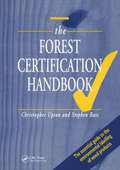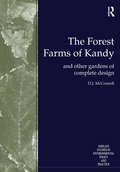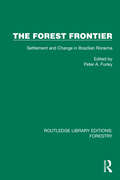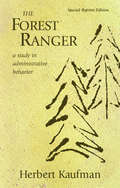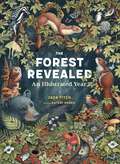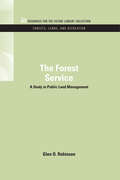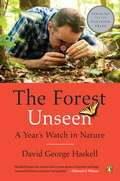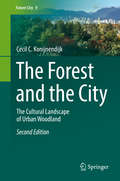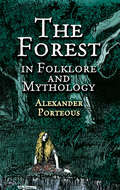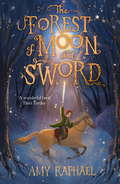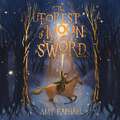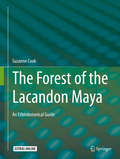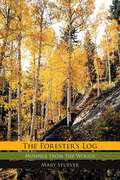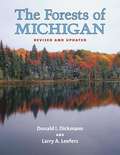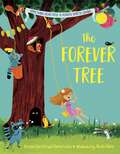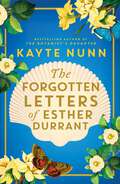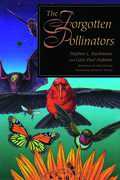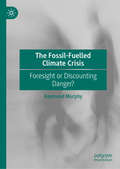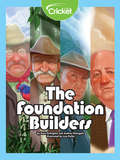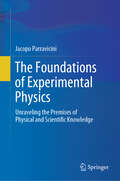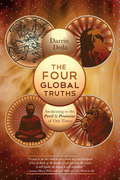- Table View
- List View
The Forest Certification Handbook
by Christopher UptonFrom forester to retailer, stakeholders in the industry are under increasing pressure to assure customers that their wood products have come from well managed, sustainable forests. The Forest Certification Handbook gives practical advice on developing, selecting and operating a certification programme which provides both market security and raises standards of forestry management. It provides a thorough analysis of all the issues surrounding certification, including the commercial benefits to be gained, the policy mechanisms required, the interpretation and implementation of forestry management standards, and the process of certification itself. Three unique directories give details of currently certified forests, international and national initiatives, and active certification programmes.
The Forest Farms of Kandy: and Other Gardens of Complete Design (Routledge Studies in Environmental Policy and Practice)
by D.J. McConnell K.A.E. Dharmapala S.R. AttanayakeThroughout the tropical world, especially in South and Southeast Asia, tropical America, Africa and Oceania, there exists a range of forest garden farming systems. These are small, low-input, but productive and sustainable family units of highly diversified trees, palms, bushes and vines, with few conventional field crops or livestock. Providing a survey of these systems around the world and an in-depth analysis of the farms around Kandy, Sri Lanka, this book offers an economic and ecological description and evaluation of this ancient agroforestry system and its relationship to a wide range of global agro-development and environmental problems. Guided by a table that lists some 30 socio-economic and social criteria by which all farming systems can and should be evaluated, the book presents persuasive evidence supported by comprehensive references. It also examines historical and archaeological findings in order to assess the role these tropical forests played in the general adoption of agricultural farming.
The Forest Frontier: Settlement and Change in Brazilian Roraima (Routledge Library Editions: Forestry)
by Peter A. FurleyOriginally published in 1994, this book analysed land developments, deforestation and pasture substitution, colonisation schemes and spontaneous settlement during the latter part of the 20th Century. In so doing, The Forest Frontier presents an overview of the intrinsic environmental and socio-economic resources of the Roraima, the most northerly of the Brazilian Amazon states. Roraima is of special environmental interest because of its extensive savannas and varied forests – the home of some of the largest and most diverse groups of indigenous Indians. This critical assessment of the nature and pace of agricultural advance into Roraima examines the range of strategies which have been proposed to cope with the inevitable development. With the conflict between preserving the natural environment and development still major issues for Brazil, this book remains as relevant now as when it was first published.
The Forest Ranger: A Study in Administrative Behavior
by Herbert KaufmanIt is the rare book that remains in print for nearly fifty years, earning wide acclaim as a classic. The Forest Ranger has been essential reading for generations of professionals and scholars in forestry, public administration, and organizational behavior who are interested in the administration of public lands and how the top managers of a large, dispersed organization with multiple objectives like the Forest Service shape the behavior of its field officers into a coherent, unified program. Published as a special reprint in conjunction with the 100th anniversary of the U.S. Forest Service, The Forest Ranger is as relevant and timely today as when it was first issued in 1960. In addition to the original text, this special reprint of The Forest Ranger includes two new forewords and an afterword that highlight how much we have learned from Herbert Kaufman. The first foreword, by Harold K. (Pete) Steen, former president of the Forest History Society, considers the book's impact on the forestry community and explains its continued relevance in light of changes in the culture and mission of today's Forest Service. The second, by Richard P. Nathan, co-director of the Rockefeller Institute of Government, considers the book's contribution to our understanding of administrative and organizational behavior. A new afterword by author Herbert Kaufman describes how his landmark study came into being and offers a candid assessment of how his theories about the agency's operations and its future have held up over time. In 1960, the Forest Service had a welldeserved reputation for excellence, and The Forest Ranger was a seminal analysis of the how's and why's of its success. Kaufman also warned, however, that an organization so unified and well adapted to its environment would have difficulties navigating social change. He was right in his concerns: The environmental, civil rights, and women's movements have all presented challenges to the character and purpose of the Forest Service, ultimately changing the organization in subtle and not-so-subtle ways. Now, as then, The Forest Ranger is a striking and prescient case study of how a complex organization operates and evolves over time.
The Forest Revealed: An Illustrated Year
by Jada Fitch Kateri KosekDiscover the amazing, fun diversity of life in the northern forest through 12 vivid paintings, each with a numbered key to search for and identify the animals, plants, insects and fungi pictured. Each of artist Jada Fitch's twelve stunning paintings represents the forest during one month of the year, featuring an array of animals, plants, insects, fungi, and other creatures common during those weeks. Opposite each painting is a list of all the species depicted, with corresponding numbers in the art, creating a search-and-find experience that will keep readers of all ages discovering more every time they look. Then turn the page to zoom in and see these creatures in even more gorgeous detail. This wondrous array of wildlife is brought further to life by writer and naturalist Kateri Kosek, who uncovers the many hidden stories and fun facts about the flora and fauna that make up the forest ecosystem, inviting you to look more closely at nature all around you. This publication conforms to the EPUB Accessibility specification at WCAG 2.0 Level AA.
The Forest Service: A Study in Public Land Management (RFF Forests, Lands, and Recreation Set)
by Glen O. RobinsonFirst Published in 2011. Routledge is an imprint of Taylor & Francis, an informa company.
The Forest Unseen
by David George HaskellA 2013 Pulitzer Prize Finalist for General Nonfiction Winner of the 2013 Best Book Award from the National Academies A Finalist for the PEN/E.O. Wilson Literary Science Writing Award Winner of the National Outdoor Book Award Winner of the Reed Award from the Southern Environmental Law Center A biologist reveals the secret world hidden in a single square meter of forest Written with remarkable grace and empathy, The Forest Unseen is a grand tour of nature in all its profundity. Biologist David George Haskell uses a one-square-meter patch of old-growth Tennessee forest as a window onto the entire natural world. Visiting it almost daily for one year to trace nature's path through the seasons, he brings the forest and its inhabitants to vivid life. Beginning with simple observations--a salamander scuttling across the leaf litter, the first blossom of spring wildflowers--Haskell spins a brilliant web of biology, ecology, and poetry, explaining the science binding together ecosystems that have cycled for thousands--sometimes millions--of years.
The Forest and the City: The Cultural Landscape Of Urban Woodland
by Cecil C. KonijnendijkAmsterdamse Bos, Bois de Boulognes, Epping Forest, Hong Kong’s country parks, Stanley Park: throughout history cities across the world have developed close relationships with nearby woodland areas. In some cases, cities have even developed – and in some cases are promoting – a distinct ‘forest identity’. This book introduces the rich heritage of these city forests as cultural landscapes, and shows that cities and forests can be mutually beneficial.Essential reading for students and researchers interested in urban sustainability and urban forestry, this book also has much wider appeal. For with city forests playing an increasingly important role in local government sustainability programs, it provides an important reference for those involved in urban planning and decision making, public affairs and administration, and even public health. From providers of livelihoods to healthy recreational environments, and from places of inspiration and learning to a source of conflict, the book presents examples of city forests from around the world. These cases clearly illustrate how the social and cultural development of towns and forests has often gone hand in hand. They also reveal how better understanding of city forests as distinct cultural and social phenomena can help to strengthen synergies both between cities and forests, and between urban society and nature.
The Forest in Folklore and Mythology
by Alexander PorteousAssembled from an enormous range of sources, this fascinating book is a mind-expanding compendium of facts, folklore, superstitions, myths, and anecdotes about trees and the forest. Included are descriptions of old forests; forest customs, temples and sacred groves; mythical forest creatures such as witches, fairies, demons, wood spirits, the "wild huntsman," and wood nymphs.The author also recounts facts and fables about individual trees, including famous trees throughout the world, unusual trees, tree worship, people's transformation into trees, and disposal of the dead in trees — as well as folklore about fossil trees, tree bark, leaves, thorns, diving rods, and Yule logs.This long-unavailable treasury of legend and lore will be welcomed by naturalists, anthropologists, students of folklore, and general readers alike.
The Forest in the Sea: Seaweed Solutions to Planetary Problems (Books for a Better Earth)
by Anita SanchezMeet an unlikely climate change hero: the wet, slimy stuff known as seaweed.Imagine forests where you can float weightlessly among schools of fish. Huge green pastures where sea turtles graze. Forests that capture carbon from seawater and breathe out oxygen. The answers to many of our planet&’s problems may lie underwater, in these forests of seaweed.Celebrated nonfiction author Anita Sanchez takes readers on a tour of seaweed forests, from the Sargasso Sea to seaweed patches off Prince Edward Island, to explore how seaweed supports marine ecosystems and plays a big role in climate change solutions. From reducing methane emissions to advances in biofuels, medicines, and more, seaweed science is at the forefront of innovation.Written with beauty and wonder, The Forest in the Sea encourages readers to think outside the box when it comes to climate change. Back matter includes recipes, activities, ways to identify and help protect seaweed, and more.Books for a Better Earth are designed to inspire children to become active, knowledgeable participants in caring for the planet they live on.Books for a Better Earth are designed to inspire children to become active, knowledgeable participants in caring for the planet they live on.A Junior Library Guild Gold Standard Selection
The Forest of Moon and Sword
by Amy Raphael"A sumptuously imagined children's debut" The Telegraph"A fast paced; single minded adventure. Female bravery is a given" The Observer When Art's mother is accused of witchcraft and captured, she is determined to get her back - at any cost. A lyrical adventure with folklore at its heart, for fans of THE HOUSE WITH CHICKEN LEGS.Twelve-year-old Art lives in a small village in Scotland. Her mother has always made potions that cure the sick, but now the townspeople say she is a witch. One cloudless night, Art's mother is arrested and taken to England. Art mounts her horse, taking a sword, a tightrope, and a herbal recipe book, and begins a journey through wild forests, using nature's signs and symbols to guide her.But will she spot the signs from the omens? Will she reach her mother, before it's too late?'A wonderful book' - Piers Torday'Very exciting' - Anthony McGowan 'Thrilling and uplifting' - Frank Cottrell-Boyce 'Gripping. I raced through it' - A.M. Howell
The Forest of Moon and Sword
by Amy Raphael'A wonderful book' PIERS TORDAY'Very exciting' ANTHONY MCGOWAN When Art's mother is accused of witchcraft and captured, she is determined to get her back - at any cost. A lyrical adventure with folklore at its heart, for fans of THE HOUSE WITH CHICKEN LEGS.Twelve-year-old Art lives in a small village in Scotland. Her mother has always made potions that cure the sick, but now the townspeople say she is a witch. One cloudless night, Art's mother is arrested and taken to England. Art mounts her horse, taking a sword, a tightrope, and a herbal recipe book, and begins a journey through wild forests, using nature's signs and symbols to guide her.But will she spot the signs from the omens? Will she reach her mother, before it's too late?'Gripping. I raced through it' - A.M. Howell, author of The Garden of Lost Secrets(P)2021 Hodder & Stoughton Limited
The Forest of the Lacandon Maya
by Suzanne CookThe Forest of the Lacandon Maya: An Ethnobotanical Guide, with active links to audio-video recordings, serves as a comprehensive guide to the botanical heritage of the northern Lacandones. Numbering fewer than 300 men, women, and children, this community is the most culturally conservative of the Mayan groups. Protected by their hostile environment, over many centuries they maintain autonomy from the outside forces of church and state, while they continue to draw on the forest for spiritual inspiration and sustenance. In The Forest of the Lacandon Maya: An Ethnobotanical Guide, linguist Suzanne Cook presents a bilingual Lacandon-English ethnobotanical guide to more than 450 plants in a tripartite organization: a botanical inventory in which main entries are headed by Lacandon names followed by common English and botanical names, and which includes plant descriptions and uses; an ethnographic inventory, which expands the descriptions given in the botanical inventory, providing the socio-historical, dietary, mythological, and spiritual significance of most plants; and chapters that discuss the relevant cultural applications of the plants in more detail provide a description of the area's geography, and give an ethnographic overview of the Lacandones. Active links throughout the text to original audio-video recordings demonstrate the use and preparation of the most significant plants.
The Forester's Log: Musings from the Woods
by Mary StueverWhen Mary Stuever graduated from forestry school in the early 1980s, her profession was facing tremendous challenges as the nation's forests were poised for serious decline from catastrophic wildfires, insect outbreaks, and suburban encroachment. Stuever captured this transition over the last few decades in her syndicated monthly column The Forester's Log. Originally penned for newspapers in rural forested communities in the Southwest, the column has found its way into various magazines, newsletters, anthologies, and Web sites.Stuever's career involves firefighting, fire rehabilitation, timber sale administration, environmental education, and many other aspects of forest management. Through her work with native tribes, local, state, and federal agencies, and private landowners, Stuever focuses on the important bond between land and people. With an inspiring and informative style, Stuever's tales weave fresh insight into forest issues. Her writings, collected here for the first time, tell the poignant story of places, people, and experiences that have shaped her passion while offering a rare glimpse of forestry in the Southwest at the turn of the new millennium.
The Forests of Michigan
by Larry A. Leefers Donald I. DickmannNo book currently on bookstore shelves explores, as The Forests of Michigan does, the natural history, ecology, management, economic importance, and use of the rich and varied forests that cover about half of the state's 36.3 million acres. The authors look at the forests, where they are, how they got to be, and their present-day usage, using the story of Michigan forests as a backdrop for the state's history, including its archaeology. The Forests of Michigan explores how the forests came back after the great Wisconsin glacier began to recede over 12,000 years ago, and how they recovered from the onslaught of unrestrained logging and wildfire that, beginning in the mid-1800s, virtually wiped them out. The emphasis of the book is on sustaining for the long term the forests of the state, with a view of sustainability that builds not only upon the lessons learned from native peoples' attitude and use of trees but also on the latest scientific principles of forest ecology and management. Generously illustrated and written in an engaging style, The Forests of Michigan sees the forest and the trees, offering both education and delight. "As forest scientists," the authors note, "we opted for a hearty serving of meat and potatoes; anyone who reads this book with the intention of learning something will not be disappointed. Nonetheless, we do include some anecdotal desserts, too." Donald I. Dickmann is Professor of Forestry at Michigan State University and holds a doctorate from the University of Wisconsin. He is the author of The Culture of Poplars. Larry A. Leefers is Associate Professor in the Department of Forestry at Michigan State University. He holds a doctorate from Michigan State University.
The Forever Tree
by Tereasa Surratt Donna LukasA fresh twist on Shel Silverstein's The Giving Tree based on a real tree in Wisconsin that became something more, this is a timeless story about loss and renewal at home and in nature."This is a true story about a Tree that grew from something more than water and sunshine. It grew from love."The animals and humans always knew their tree was special. The trunk was the best place to host championship bingo tournaments, and the branches were perfect for swinging in the shade! But when the tree gets sick, neighbors new and old will have to join forces if they have any chance of saving their treetop home.A touching tale based on the true story of one special tree, and the community that brought it back to life.
The Forever Tree (Fountas & Pinnell Classroom, Guided Reading Grade 3)
by Marthe JocelynNIMAC-sourced textbook
The Forgotten Founders: Rethinking The History Of The Old West
by David Emmons Stewart L. UdallIn The Forgotten Founders, Stewart Udall draws on his vast knowledge of and experience in the American West to make a compelling case that the key players in western settlement were the sturdy families who travelled great distances across forbidding terrain to establish communities there. He offers an illuminating and wide-ranging overview of western history and those who have written about it, challenging conventional wisdom on subjects ranging from Manifest Destiny to the importance of Eastern capitalists to the role of religion in westward settlement.Stewart Udall argues that the overblown and ahistorical emphasis on a "wild west" has warped our sense of the past. For the mythical Wild West, Stewart Udall substitutes a compelling description of an Old West, the West before the arrival of the railroads, which was the home place for those he calls the "wagon people," the men and women who came, camped, settled, and stayed. He offers a portrait of the West not as a government creation or a corporate colony or a Hollywood set for feckless gold seekers and gun fighters but as primarily a land where brave and hardy people came to make a new life with their families. From Native Americans to Franciscan friars to Mormon pioneers, these were the true settlers, whose goals, according to Stewart Udall were "amity not conquest; stability, not strife; conservation, not waste; restraint, not aggression." The Forgotten Founders offers a provocative new look at one of the most important chapters of American history, rescuing the Old West and its pioneers from the margins of history where latter-day mythmakers have dumped them. For anyone interested in the authentic history of the American West, it is an important and exciting new work.
The Forgotten Letters of Esther Durrant: The new gripping and heartbreaking historical novel from the bestselling author of The Botanist's Daughter
by Kayte Nunn'I loved this exquisitely written novel and drank in every word. The Forgotten Letters of Esther Durrant is a reminder of the redemptive nature of love, and that it can be found in the most unexpected places.' Fiona Valpy, bestselling author of The Dressmaker's Gift and The Beekeeper's PromiseAn abandoned woman...1951. Esther Durrant, a young mother, is committed to an asylum by her husband. Run by a pioneering psychiatrist, the hospital is at first Esther's prison - but can captivity lead to freedom?A forbidden love...2018. When free-spirited marine scientist Rachel Parker is forced to take shelter on an isolated island off the Cornish Coast during a research posting, she discovers a collection of hidden love letters. Captivated by their passion and tenderness, Rachel is determined to find the intended recipient. A dangerous secret...Meanwhile, in London, Eve is helping her grandmother write her memoirs. When she is contacted by Rachel, it sets in motion a chain of events that threatens to reveal secrets kept buried for more than sixty years. Three women bound together by a heartbreaking secret. A love story that needs to be told.This beautifully haunting and atmospheric novel, will sweep fans of Kate Morton, Elizabeth Gilbert and Emily Gunnis away this summer.'If you enjoyed "City of Girls," by Elizabeth Gilbert, read "The Forgotten Letters of Esther Durrant," by Kayte Nunn' Washington PostNetGalley reviewers are falling in love with The Forgotten Letters of Esther Durrant:'Loved, loved this book. The multi layers wove an intriguing tale, and this was a well researched engaging and heart rending story.''Beautifully written''An absorbing tale set mainly in the Channel Islands. I wanted to know what the resolution would be, so stayed up to read to the end!'Praise for Katye Nunn's The Botanist's Daughter:'A sweeping and exotic read. I was completely swept away. Perfect for readers of Kate Morton.' Lorna Cook, bestselling author of 'The Forgotten Village''The whole book is a delight... Perfect reading whilst sipping a g & t in a beautiful garden somewhere in the sun!' Rosanna Ley, bestselling author of 'The Lemon Tree Hotel''I loved this book and really look forward to reading the next book by Kayte Nunn; perfect for reading in the garden with a glass of something cold.' Bookliterat'Fast-moving and full of surprises...while delivering a poignant and heart-warming story of romance and new beginnings ' Kate Forsyth'The Botanist's Daughter is a quick paced but mysterious read, which transports you across time and place and is filled with an abundance of flowers.' Foreword Books'The Botanist's Daughter is an intriguing story about the strength of women who, for their own reasons, are willing to travel halfway across the world and end up with the same goal. It's also a family mystery that slowly reveals its secrets, just like a blooming flower.' The Bookish Gurl 5/5 stars
The Forgotten Pollinators: Dynamics And Restoration Of Abandoned Farmland
by Gary Paul Nabhan Paul Mirocha Stephen L. BuchmannConsider this: Without interaction between animals and flowering plants, the seeds and fruits that make up nearly eighty percent of the human diet would not exist.In The Forgotten Pollinators, Stephen L. Buchmann, one of the world's leading authorities on bees and pollination, and Gary Paul Nabhan, award-winning writer and renowned crop ecologist, explore the vital but little-appreciated relationship between plants and the animals they depend on for reproduction -- bees, beetles, butterflies, hummingbirds, moths, bats, and countless other animals, some widely recognized and other almost unknown.Scenes from around the globe -- examining island flora and fauna on the Galapagos, counting bees in the Panamanian rain forest, witnessing an ancient honey-hunting ritual in Malaysia -- bring to life the hidden relationships between plants and animals, and demonstrate the ways in which human society affects and is affected by those relationships. Buchmann and Nabhan combine vignettes from the field with expository discussions of ecology, botany, and crop science to present a lively and fascinating account of the ecological and cultural context of plant-pollinator relationships.More than any other natural process, plant-pollinator relationships offer vivid examples of the connections between endangered species and threatened habitats. The authors explain how human-induced changes in pollinator populations -- caused by overuse of chemical pesticides, unbridled development, and conversion of natural areas into monocultural cropland-can have a ripple effect on disparate species, ultimately leading to a "cascade of linked extinctions."
The Fortune of War ( Aubrey/Maturin Novels #6)
by Patrick O'BrianCaptain Jack Aubrey, R. N., arrives in the Dutch East Indies to find himself appointed to the command of the fastest and best-armed frigate in the Navy. He and his friend Stephen Maturin take passage for England in a dispatch vessel. But the War of 1812 breaks out while they are en route. Bloody actions precipitate them both into new and unexpected scenes where Stephen's past activities as a secret agent return on him with a vengeance.
The Fossil-Fuelled Climate Crisis: Foresight or Discounting Danger?
by Raymond MurphyThis book analyses the threat posed by the continued use of fossil fuels. By utilizing Elizabeth Shove’s social practices approach and Murphy’s own social closure framework, the book examines the accelerating treadmill of carbon-polluting practices. It incorporates externalities theory to investigate how the full cost of fossil fuels is paid by others rather than users, and to demonstrate that the environmental commons is a medium for conveying intergenerational monopolisation and exclusion in the Anthropocene. Murphy uncovers a pattern of opposition to change when exploiting valuable but dangerous resources. He argues that a new faith in mastering nature is emerging as a belief in just-in-time technological solutions to circumvent having to change fossil-fuelled practices.The book then moves on to assess proposed solutions, including Beck’s staging of risk and his hypothesis that the anticipation of global catastrophe will incite emancipation. It proposes a novel approach to enhancing foresight and avoid incubating disaster. It will appeal to readers interested in an original social science analysis of this creeping crisis and its resolution.
The Foundation Builders
by Gina DeAngelisLearn about America's founding conservationists: Theodore Roosevelt, Gifford Pinchot, Stephen T. Mather, Hugh Hammond Bennett.
The Foundations of Experimental Physics: Unraveling the Premises of Physical and Scientific Knowledge
by Jacopo ParraviciniStandard STEM courses, for all of their value, do not tend to include systematic lectures or treatment about the nature of the scientific method. This book aims to provide a wide reflection on the general principles of physics and explore the foundations of scientific knowledge as a whole. The author delves into the study of what lies at the basis of science in general, and physics in particular. Themes such as the relation between natural phenomena and mathematical language are addressed, highlighting the main hubs of conceptual development in science. The volume also examines the conceptual and practical instruments that have been progressively developed to investigate the nature of physics. Furthermore, the author discusses the importance of “scientific practice” within the scientific community, emphasizing its role in advancing knowledge and how it contributes to physics as a whole. Divided into three parts, each covering different aspects of physics and its foundations, the text, while assuming basic knowledge of physics and mathematics taught in university courses, is accessible to all STEM students, and will be useful for anyone looking to gain valuable insights into the nature of physics and the methods used to acquire knowledge in this field.
The Four Global Truths
by Darrin DrdaWith the planet increasingly threatened with catastrophe and perhaps even collapse, many seekers are looking to past, proven models to create meaningful change in their lives. One such model is Buddhism's Four Noble Truths: the reality of suffering, the root cause of suffering, the end of suffering, and the path to the end of suffering. This fresh, timely book taps and modifies that ancient wisdom to address the pressing environmental and spiritual crises facing us. In The Four Global Truths, author Darrin Drda contends that as global temperatures rise and natural systems decline, humanity is forced to confront the destructiveness of unfettered material progress and mechanistic thinking. He posits a more enlightened worldview that honors the interdependence of all forms of life and aspects of reality, a concept increasingly see as a practical and compassionate approach to averting disaster. Writing in a warm, open style recalling that of Eckhart Tolle in The New Earth, Drda integrates elements of Western philosophy, transpersonal psychology, deep ecology, modern cosmology, and quantum physics to get at the heart of worldwide ecological suffering. In the process he encourages a responsible and joyful--and ultimately healing--participation in this critical moment in life.About the Imprint: EVOLVER EDITIONS promotes a new counterculture that recognizes humanity's visionary potential and takes tangible, pragmatic steps to realize it. EVOLVER EDITIONS explores the dynamics of personal, collective, and global change from a wide range of perspectives. EVOLVER EDITIONS is an imprint of North Atlantic Books and is produced in collaboration with Evolver, LLC.From the Trade Paperback edition.
